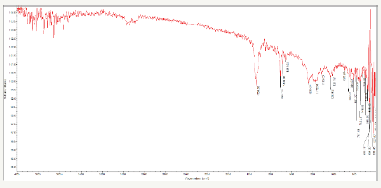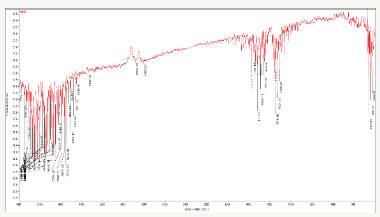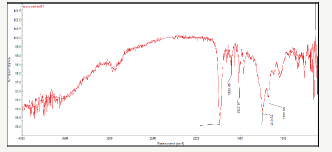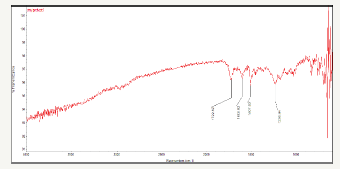- Submissions

Full Text
Academic Journal of Engineering Studies
Fourier Transform Infrared (FT‐IR) Spectra Characterization of Recycled Carbon Fiber Composites: Mini Review
Azadeh Tavousi Tabatabaei1,2, Seyed Hossein Mamanpush1* and Bahareh Tavousi Tabatabaei3
1 Composite Materials and Engineering Center, USA
2 Department of Chemistry, Iran
3 Department of Engineering, Iran
*Corresponding author: Seyed Hossein Mamanpush, Composite Materials and Engineering Center, Pullman, Washington 99163, USA
Submission: October 10, 2018;Published: November 09, 2018
.jpg)
ISSN:2694-4421 Volume1 Issue1
Abstract
Post-industrial off-cuts of carbon fiber epoxy and carbon fiber vinyl ester composites recycled mechanically and characterized by Fourier transform infrared (FT‐IR) to obtain an infrared spectrum of absorption or emission of the untreated and heat-treated recycled carbon fiber composites. FT‐IR spectra were recorded with a Bomem MB series FT‐IR spectrophotometer.
FTIR Characterizationn
The use of carbon fiber composites (CFCs) is dramatically increasing due to their higher fatigue life, better corrosion and fire resistance, and more flexible design options over conventional materials. The process from manufacturing carbon fiber to production of finished components is wasteful; it is estimated that more than 30% of produced carbon fiber ends up as waste at some point in the process. Unlike their metal counterparts, wastes produced during synthetic-fiber composites (SFCs) manufacturing and assembly, along with end-of-life products, have limited options for reuse [1- 3]. Options to incinerate or disposal has negative environmental contributions and disregards the potential recycled CFCs have as a feedstock for second generation products. There is a potential to recycle the carbon fiber from the thermoset matrix via chemical or thermal treatments, however the resulting fiber is often lower in mechanical properties than virgin fibers and are very difficult to disperse into many matrices due to their crimped and entangled form. Mechanical techniques that employ shredders, hammer-mills, knife-mills, etc. provide a low-cost option to deliver a reliable feedstock. Mechanical recycling is a low-cost and energy-efficient method for CFCs [4-6].
FT‐IR spectra of untreated and heat-treated mechanically recycled carbon fiber epoxy and carbon fiber vinyl ester composites (CFC) are shown in Figure 1-4 respectively. The spectra of epoxybased CFC show a band at 1507cm−1, corresponding to C-H bending and a band at 1734cm−1 assigned to the C=O [3-4]. The FT‐IR spectrum of vinyl ester-based CFC exhibits a band at 1716cm−1 corresponding to the C=O and a band at1540cm−1[7-9].
Figure 1:FT-IR spectra of epoxy-based CFC.

Figure 2:FT-IR spectra of Vinyl ester-based CFC. Comparing FT-IR of untreated and heat treated rCFC indicates that there is no significant difference between their spectra.

Figure 3:FT-IR spectra of heat-treated epoxy-based CFC.

Figure 4:FT-IR spectra of heat-treated Vinyl ester-based CFC.a

References
- Mamanpush H, Golestanian H (2014) Investigating the effects of carbon nanotube orientation on the macroscopic stiffness of nano composites. International Journal of Current Life Sciences 4(4): 1168-1174.
- Mamanpush H, Golestanian H (2014) Evaluation of effective material properties of randomly distributed carbon nanotube composites considering interface effect. Indian Journal of Scientific Research 2(1): 132- 142.
- Mamanpush H, Golestanian H (2014) Effects of carbon nanotube dispersion on the mechanical properties of nanocomposites considering interface effect. International Journal of Current Research 4(8): 4366-4373.
- Shaabani A, Seyyed EH, Azadeh TT (2015) Synthesis of fully substituted naphthyridines: a novel domino four-component reaction in a deep eutectic solvent system based on cholinechloride/urea. Tetrahedron Letter 57(3): 351-353.
- Ahmad S, Ronak A, Seyyed EH, Azadeh TT, Hajishaabanha F (2016) Copper supported on MWCNT guanidine acetic acid@Fe3O4: Synthesis, characterization and application as a novel multi-task nanocatalyst for preparation of triazoles and bis(indolyl) methanes in water. RSC Adv 6: 18113-18125.
- Seyed HM, Hui L, Karl E, Azadeh TT (2018) Recycled wind turbine blades as a feedstock for second generation composites. Waste Manag 76: 708- 714.
- Shabnam S, Azadeh TT, Ahmad S (2016) Copper(I) oxide nanoparticles supported on magnetic casein as a bio‐supported and magnetically recoverable catalyst for aqueous click chemistry synthesis of 1,4‐disubstituted 1,2,3‐triazoles. Applied Organometallic Chemistry 31(2):
- Seyed HM, Azadeh TT, Hui L, Karl E (2018) Data on the mechanical properties of recycled wind turbine blade composites. Data in Brief 19: 230- 235.
- Seyed HM, Hui L, Karl E, Azadeh TT (2018) Dataset demonstrating physical properties of recycled wind turbine blade composites. Data in Brief 20: 658-661.
© 2018 Seyed Hossein Mamanpush. This is an open access article distributed under the terms of the Creative Commons Attribution License , which permits unrestricted use, distribution, and build upon your work non-commercially.
 a Creative Commons Attribution 4.0 International License. Based on a work at www.crimsonpublishers.com.
Best viewed in
a Creative Commons Attribution 4.0 International License. Based on a work at www.crimsonpublishers.com.
Best viewed in 







.jpg)






























 Editorial Board Registrations
Editorial Board Registrations Submit your Article
Submit your Article Refer a Friend
Refer a Friend Advertise With Us
Advertise With Us
.jpg)






.jpg)














.bmp)
.jpg)
.png)
.jpg)










.jpg)






.png)

.png)



.png)






